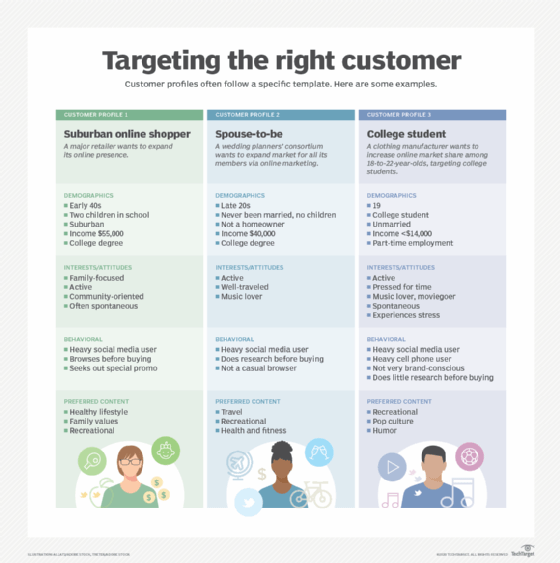How to create customer profiles, with examples
Creating customer profiles gives brands a deep understanding of customers' needs and results in more successful marketing strategies. Here are the steps to get started.
To create consistently excellent CX, organizations must understand their customers and what their preferences are at any stage in their journeys. Trust and brand loyalty depend on this.
It takes time to build this level of knowledge about customers, because CX teams discover individual preferences and unique needs as the relationship deepens. Yet, none of this is possible without a solid starting point that triggers a connection between an existing or new customer and the brand to spur the desired action. This is the role of the customer profile.
Think of the customer profile as the embodiment of the ideal customer, gleaned through analysis of a company's own customer data and market knowledge. A customer profile -- sometimes referred to as a buyer persona -- accounts for factors like demographics, buying behavior, lifestyle characteristics, goals, values, pain points and challenges. Importantly, various functional roles should benefit from the customer profile, including but not limited to CX and marketing.
Without a well-defined customer profile, teams may struggle to create and send marketing campaigns, product promotions, sales incentives and other customer outreach. Whether consumers or businesses, buyers are getting savvier by the day. To grab and maintain their attention, outreach must reflect who they are and what they need.
B2B vs. B2C customer profiles
Indeed, the customer profile imperative applies equally to B2C and B2B companies. Whether the targets are individual consumers or corporate buyers, the customer profile should establish an understanding of customers so the company can actively engage with them, optimize service and support, ensure purchasing or other goals, and ultimately drive business success.
In either case, B2B and B2C customer profiles must be living documents, refreshed regularly based on data and insights to keep pace with changing customer preferences, market evolution, new product availability and so on.
B2B customer profiles, however, are more nuanced than B2C customer profiles. While the ideal customer defined in a B2C customer profile is an individual, the ideal customer defined within a B2B customer profile may be an organization itself, in addition to an individual with buying authority. So, a B2B customer profile must account for company-level factors such as industry, number of employees, revenue, location, technology footprint and growth goals, as well as buyer demographics such as department, experience, job title and seniority.
Other differences include buyer motivation, the decision-making process and the relationship between the customer and company. A B2C customer profile understands that the relationship is largely transactional, although building brand loyalty is an important goal. It accounts for soft, emotional connections and personal desires of an ideal customer, who makes decisions comparatively quickly. On the other hand, a B2B customer profile aims to build long-term relationships and partnerships, developed around an understanding of a business's desire to improve hard metrics, such as ROI, cost reduction or scalability.
Types of customer profiling
A well-defined customer profile lets companies refine marketing campaigns, product promotions, sales incentives and other customer outreach to elevate their appeal to targeted buyers. When building customer profiles, CX, marketing, sales and other business leaders tend to use demographic, geographic and behavioral data.
1. Demographic profiling
Demographic data is fundamental because it defines the who. It's also often the easiest type of profiling to do, because it uses factual data points about individuals or organizations.
For B2C customer profiles, typical demographics relate to age, education, employment, gender, household status, income, location, marital status and race/ethnicity. For B2B, organizational demographics include company size, customer base, growth stage, legal structure, location, revenue model and specific industry.
Demographic profiling often goes hand in hand with psychographic profiling, which includes factors such as attitudes, interests and values.
2. Geographic profiling
Geographic profiling assumes people or organizations in the same geographic region have similar needs, preferences and purchasing behaviors. Location, including neighborhood, city, state, country or region, is the basic variable. However, geographic profiling may also consider climate and seasonality, competition in the area, cultural preferences, language, local traditions, population density, religious activity and time zone. Geographic profiling particularly helps create localized marketing campaigns, inform pricing strategies and understand market expansion.
3. Behavioral profiling
This type of profiling brings what customers do, such as interactions with a brand, into the profile. It includes insights into purchasing habits, spending patterns, brand interactions and how customers use products or services. This sort of information can inform upsell and cross-sell opportunities, identify opportunities for personalized outreach and recommendations, and generally improve CX.
How to create a customer profile
Creating a customer profile involves a systematic approach to gather, analyze and apply customer data. Ideally, customer profiles involve multiple departments, including marketing, product and sales -- all of which benefit from having the ideal customer scoped out.
The following are key steps to create a customer profile:
1. Define the goal and scope
This step is foundational, informing all steps beyond it. Key questions to ask in this phase include the following:
- What's the goal of a customer profile?
- Is a single customer profile optimal, or profiles for different segments?
- Who will use the customer profile, and how will they use it (creating market campaigns, optimizing CX, improving sales opportunities, etc.)?
2. Collect customer data
This is the information-gathering phase, which aims to build a comprehensive picture of customers. It should include quantitative data from the company's CRM, sales platform and other sources, and qualitative data, including conversations, customer feedback and social listening.
3. Identify customer segments
Data analysis follows data collection. During this phase, teams should uncover commonalities among customers, such as characteristics and pain points, and gain insights into customer behaviors to facilitate segmentation.
4. Develop the persona and write the customer profile
Create a clear, easy-to-read customer profile that meets cross-organizational needs. This could take various forms, like a document, an infographic or a slide presentation.
Don't stop working on the persona after creating it, either. Regularly review and update it.
5. Take customer feedback
Gather feedback for each initiative launched using a customer profile. What did customers like or not like? Were they satisfied? Did their loyalty grow? Use these findings to refine customer profiles and measure repeatedly.

Examples of customer profiles
Customer profiles often follow a specific template, as shown in the following examples:
1. Suburban online shopper
Sheila is a college-educated, working mother of two in her early 40s. She is family-focused, community-oriented and lives a healthy lifestyle. She loves social media, does a lot of online browsing and gravitates toward purchasing when she's offered special promos.
A retailer's reach, attract, retain campaign for Sheila's customer profile would entail the following:
- Reach: Use hyper-targeted social media ads and local online initiatives to appear where she's already active, which can build brand visibility within her digital and local communities.
- Attract: Engage Sheila with compelling value propositions through prominent promotions, family-centric content and a seamless, mobile-friendly online browsing experience that includes convenient fulfillment options.
- Retain: Offer comprehensive post-purchase support, personalized communications and opportunities for community engagement to foster long-term loyalty.
2. Spouse-to-be
Mary, who is in her late 20s, is engaged to be married. She's active, well-traveled and loves music. She rents her apartment, with an income of $40,000. She uses social media daily and does a lot of research before buying anything, but isn't a casual browser.
A reach, attract, retain campaign for a wedding planners' consortium looking to expand the market for all its members would entail the following:
- Reach: Connect with Mary on visually driven social platforms, such as Instagram, TikTok and Pinterest, through aspirational wedding content and targeted ads, embracing engagement signals around wedding planning.
- Attract: Capture her attention with highly curated, inspiring content, personalized product recommendations based on her research and clear value propositions, such as unique options, quality and affordability, that directly address her wedding planning needs.
- Retain: Build lasting loyalty with exclusive offers for future life events -- for example, home buying and family planning, along with opportunities to share her experience and inspire others within the wedding and newlywed community.
3. College student
Jake is a busy, stressed-out college student who loves music, movies, pop culture and humor. He uses social media and his cell phone heavily. He isn't at all brand-conscious and typically buys spontaneously.
The reach, attract, retain strategy for a clothing manufacturer targeting college students to expand its online share among 18- to 22-year-olds would entail the following:
- Reach: Saturate popular social media platforms, such as TikTok, Instagram and YouTube, with short-form, trending and humorous content that features clothing integrated into relatable student life, music and movie references.
- Attract:. Drive spontaneous purchases with timely, low-friction and value-oriented promotions, such as flash sales or student discounts, promoted through entertaining, pop culture-driven content that makes the clothing feel accessible and fun, and emphasizes immediate gratification.
- Retain: Consistently offer fresh, relevant and entertaining pop culture-infused content to encourage repeat spontaneous buys. Work with his cell phone habits for seamless re-engagement, and occasionally surprise him with exclusive, lighthearted offers.
Beth Schultz is vice president of research and principal analyst at Metrigy. She focuses her research on unified communications, collaboration and digital customer experience.







